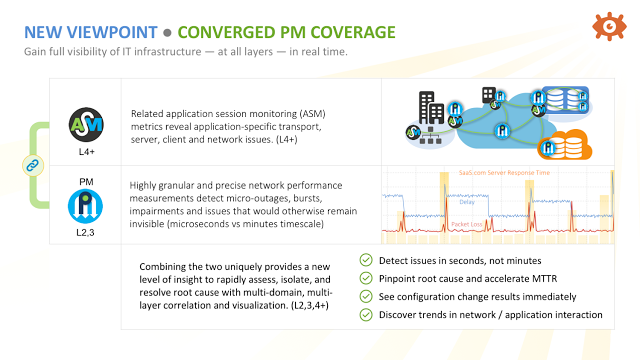Digital transformation promises to make enterprises more competitive. But identifying, locating, and resolving network and user experience issues associated with cloud and SaaS complicates matters.
The majority of enterprises with a formal ‘digital transformation’ strategy see cloud and software-as-a-service (SaaS) migration—backed by a highly available, fast, resilient IT infrastructure—as being foundational for their competitive differentiation, 451 Research found in a 2017 survey of enterprise IT decision-makers. Hardly surprising; the extended network—spanning branch offices, private data centers, and public clouds—is now a strategic asset, with 43% of enterprises reporting that their competitive position deteriorated due to poor IT infrastructure performance.
The digital transformation performance gap
The digital transformation promises to make businesses cloud-competitive, while increasing operational efficiency and driving out risk and cost. But, while the shift to cloud services has accelerated, the time required to identify, locate, and resolve network and user experience issues has not. Nearly 80% of enterprises take longer than an hour to mitigate service outages, while productivity-killing performance degradation and intermittent impairments are often overlooked, or left unresolved entirely.
Such is the key challenge faced by enterprises during their migration to a widely-distributed WAN, which involves increasingly taxed IT infrastructure. Industry surveys by Unisphere Research, Ponemon Institute, Gartner, and Aberdeen Group put the cost of IT and network impairments at $1,000 per user, per year. An organization with 10,000 employees, therefore, can expect $10,000,000 in lost productivity, lost revenue, and unplanned IT spending.
It’s no wonder enterprises are looking for support to close this performance gap, which is interfering with their goal to create a unified, seamless, automated experience for customers across cloud-scale IT infrastructure. More than 30% of enterprises rely on communications service providers (CSPs) as key partners in this front, counting on them for hosted and managed services, performance monitoring, and professional services, in addition to connectivity. (This is part of a larger trend, where IT organizations now regularly manage multiple service providers—for WAN and connectivity, security, cloud infrastructure, and SaaS—to create a cohesive IT infrastructure.)
Performance assurance is undoubtedly an issue, but it need not be. What’s needed is a new way to look at network performance monitoring, to ensure that the behavior of these dynamic services, and the networks that support them, can be seen through a single lens.
Digital transformation changes how networks and applications interact
The result of the trends discussed above is a cross-pollination of CSP and enterprise IT domains. Enterprises that traditionally focused on infrastructure and application performance now need to manage increasingly large national or multinational networks. And, service providers that have built their businesses delivering high availability, assured connectivity now need application session monitoring to deliver more value to their customers.
For enterprises and CSPs alike, the increasing interdependence between LAN, WAN, server, and client means that troubleshooting and optimizing application performance and user experience now requires insight into all layers and locations.

Traditionally, the monitoring tools used by IT and service providers are quite different:
Enterprises have focused on user experience and application performance using wire analysis, passive monitoring, and application-aware network performance monitoring (AA-NPM). While these tools do report detailed, application-specific data, they only do so on a 5-15 minute scale, which is inadequate for assuring cloud and SaaS user experience.
CSPs have relied on ultra-precise network-layer performance monitoring (PM) systems to deliver carrier-grade reliability and to report on SLA compliance to their customers. These tools measure the underlying network performance in high definition—up to 300 times a second—to detect microbursts and outages that, while short-lived, can significantly impact applications. But, direct insight into the user experience is lacking.
Increasingly, both sets of tools must be used together to solve enterprise connectivity problems. The speed of PM insight, combined with the application-aware, user experience insight provided by AA-NPM solutions, permit correlation that reveals the precise location, impact, and cause of outages. They can also detect more subtle degradations, recurring-yet-transient issues, and situational impairments that have a large impact on productivity.
Virtualization brings digital transformation tools together
Until now, the cost of both tool sets, and the lack of integration between them, have siloed each, and made it complex and expensive to deploy them together. The advent of virtualization has resulted in a new breed of monitoring solutions that cover the full spectrum—from precise, granular network layer metrics to sophisticated application session, transport and experience monitoring.

A single monitoring platform can now integrate high-capacity virtualized monitoring probes, agents that reside on cloud infrastructure, and passive monitoring functions (virtual network functions/VNFs) that can detect and pinpoint issues with SaaS, private and public cloud, WAN, LAN, and clients—even in bring-your-own-device (BYOD) environments.
This pervasive visibility supports, facilitates, and assures the full cloud migration lifecycle, from validating network readiness; to selecting candidate applications, clouds and services; to baselining performance before and after migration. Once in production, it offers the insight required for continuous performance tuning, offload balancing, rapid troubleshooting, and predictive analytics for network and compute capacity planning.

Both enterprises and CSPs can benefit from this enhanced visibility to assure and accelerate digital transformation, adding value to each party as they partner to ensure their networks truly are strategic assets.

 Improved delivery, better visibility: How Accedian and VMware are working together to help CSPs navigate the 5G world
Improved delivery, better visibility: How Accedian and VMware are working together to help CSPs navigate the 5G world
 Adding a new dimension of visibility to the Cisco Full-Stack Observability portfolio with Accedian Skylight
Adding a new dimension of visibility to the Cisco Full-Stack Observability portfolio with Accedian Skylight